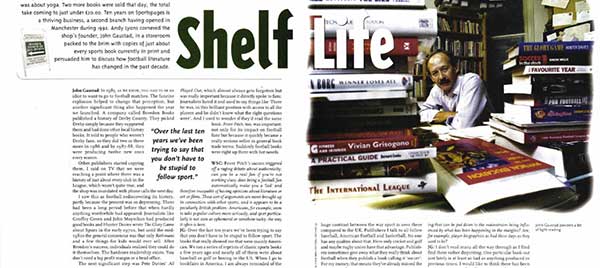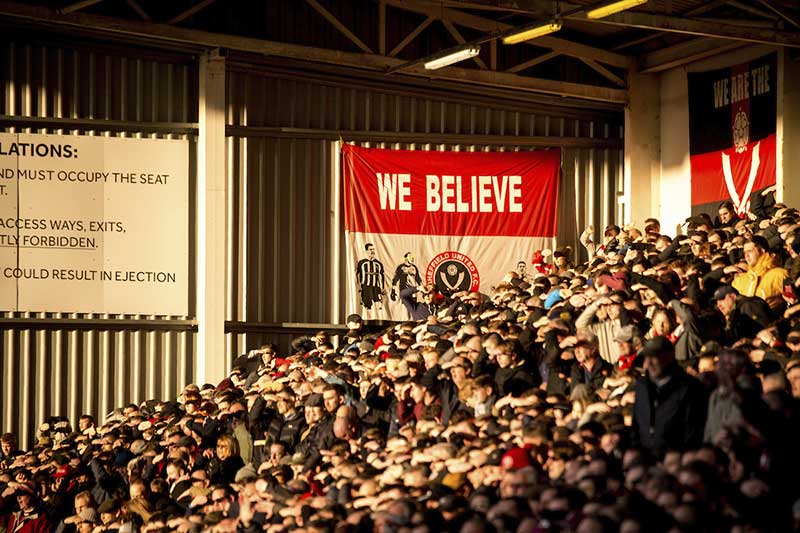
Search: 'fanzines'
Stories
Gaustad also created the William Hill Sports Book of the Year award
7 June ~ John Gaustad, the founder of the influential bookshop Sportspages, died over the weekend. The first Sportspages was opened on Caxton Walk, just off Charing Cross Road, in London in 1985 and became hugely important in the rise of sports literature, offering fans and journalists a dedicated place to go to find writing about football. The shop was also one of the early stockists of WSC, as well as many other fanzines at that time. Gaustad went on to co-found the William Hill Sports Book of the Year award in 1989 and opened a second branch of the shop in Manchester in 1992.
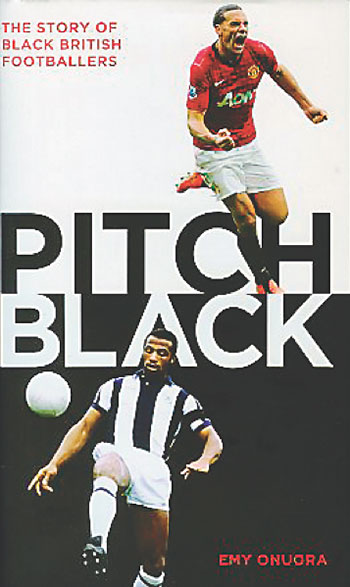 The story of black
British footballers
The story of black
British footballers
by Emy Onuora
Biteback Publishing, £16.99
Reviewed by Paul Rees
From WSC 341 July 2015
The issue of racism in football remains sadly pertinent, as indicated by serial incidents at games in eastern Europe and the taunting of a black man by Chelsea supporters ahead of a Champions League fixture in Paris earlier this year. As such, there is a requirement for a definitive history covering the emergence and ultimate triumph of black footballers in the British game. Emy Onuora would seem to be well-placed to produce it. Brother of erstwhile Huddersfield, Gillingham and Swindon striker Iffy Onuora and a race relations scholar, he promises to bring a unique perspective to his subject but never manages to mould that into a gripping narrative.
Pitch Black is strong on basic detail. It capably charts the rise through the 1970s of players such as Clyde Best at West Ham and West Brom’s so-called Three Degrees, Cyrille Regis, Laurie Cunningham and Brendon Batson, relating the vile abuse these early trailblazers were routinely subjected to at grounds across the country. Similarly, Onuora sheds light on the tales of less familiar names. Among them are those of Bradford City’s Ces Podd, the first black British footballer to be granted a testimonial, and Calvin Plummer, a promising young forward with Nottingham Forest press-ganged onto a tour of apartheid-era South Africa by his manager, Brian Clough. However, Pitch Black is undone by the author’s dry writing style, often reading like an academic dissertation, and his unfortunate tendency to continually repeat the same facts.
Onuora’s book also suffers from his apparent lack of access. He recounts the chastening experiences of one black footballer after another, but the reader is deprived of first-hand accounts. As a result Regis, Batson, Garth Crooks, Ian Wright and others pass through Pitch Black like ciphers and with no new flesh being put on the bones of their stories. Onuora is scant on the contemporary game too. The likes of Danny Welbeck, Daniel Sturridge and Raheem Sterling are all but invisible and he skips over the Luis Suárez and John Terry controversies with undue haste.
Frustratingly, there are the beginnings of a more rounded book here. Onuora touches upon such disparate but integral themes as the upsurge of the National Front, the role taken by football fanzines in confronting racism on the terraces head-on and the paucity of black managers and Asian footballers in the British game, but without burrowing down to extract deeper truths. Other than passing references to evolving hairstyles and “high-five” goal celebrations, he is remiss in tracing the strong influence black culture has had on football and the wider society in this country. Reggae, ska and hip-hop, to name but three black musical forms of incalculable significance, barely rate a mention.
Doubtless, there is a fascinating and important book to be written on this subject, one that is as much a social and cultural document of record on post-war Britain as it is about football. It is a shame that Pitch Black isn’t it.
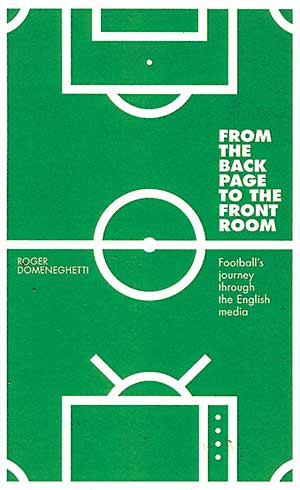 Football’s journey through the English media
Football’s journey through the English media
by Roger Domeneghetti
Ockley Books, £12.99
Reviewed by Tom Davies
From WSC 339 May 2015
We are frequently told that both the media and football have become distortingly all-pervasive, so a history of the relationship between the two would appear long overdue. In this exhaustively well-researched book Roger Domeneghetti delves deeply not just into the earliest histories of both but into what initially seem like diversionary tangents – betting, gaming and comic strips. If these are occasionally longer than they need to be, they do at least fit the author’s wider, convincing narrative of mutual interdependence.
Tracing this many-tentacled history, from the newspaper boom in the late 19th century through to the Premier League, Sky and Twitter, it is obvious how football and the media industry have always fed off each other. We may rail against kick-off times being switched at the behest of TV companies but the “traditional” Saturday 3pm start is rooted in media demands. Regional newspapers in the late 1800s required standardised kick-off times to suit Saturday evening edition deadlines. Into the 20th century, early newsreels looked to play up talking points and personalities. Sport drove radio sales and provided events for the newly established BBC to build itself around.
A common theme is the authorities’ inability to prevent themselves being outwitted, or to protect the game’s wider interests. From the wrangling with the BBC that obstructed the broadcast of inter-war Cup finals to the way the FA allowed themselves to be outflanked by the TV companies and Premier League, wearily familiar shortcomings persist.
The BBC’s agreement to pay the FA £1,000 to broadcast the 1953 FA Cup final “set the template for football coverage to this day”, not least in investing the “Matthews final” with symbolism. Competition between broadcasters changed the game again: “If the football authorities were unclear as to how exactly their relationship with television should develop, neither the BBC nor their rivals had any such doubts,” writes Domeneghetti.
The chapter on the development of newspaper journalism sheds light on the changing status of players and their relationship with reporters, as well as on the way those papers have altered, with the expansion of broadsheet coverage flattening their distinction with the red tops; writers move between both with increasing frequency. Fanzines are also given their due for changing how football was written about in the mainstream.
Domeneghetti is a press box regular himself and writes about football for the Morning Star, so as might be expected a strong social-political context frames his narrative. This, and a breezy conversational style, ensures that the dominant perspective here is that of the ordinary fan/reader/viewer. Media-analyst business-speak is thankfully lacking.
Of course we end on blogs and social media, which have given both fans and players more of a voice while posing challenges to the traditional industry. “The process of becoming a football writer’s become more democratised,” Jonathan Wilson points out here, yet making a living from it becomes ever more precarious. The contention that football is central to new media might be overstated, but not by much, though the deaths of various sectors (radio, newspapers) have been predicted many times, and not always accurately. Instead, they’ve muddled through, much like clubs themselves.
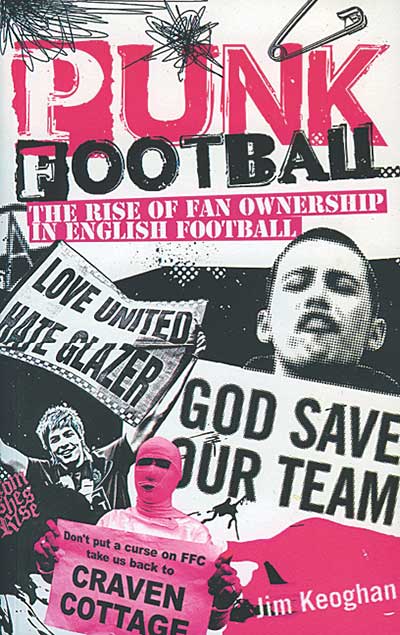 The rise of fan ownership in English football
The rise of fan ownership in English football
by Jim Keoghan
Pitch Publishing, £12.99
Reviewed by Tom Davies
From WSC 332 October 2014
It is surprising that the rising supporter activism of the past three decades – from the inky anger of 1980s fanzines to the thoughtful campaigning on governance and club ownership of the supporters’ trust movement – has not been more widely chronicled. Jim Keoghan has made one of the few readable stabs at drawing all these stories together in Punk Football, which traces how fan protest has shaped the game in recent times, including where it has failed and the formidable forces it is up against.
With a useful introductory section looking at the history of how English football and its clubs came to be organised as they are, with the transition from members’ clubs to private companies that accompanied the rise of professionalism and mass spectatorship at the back end of the 19th century, Keoghan rightly places the structure of clubs at the centre of the story. So developments such as the abolition of the maximum wage, the formation of the Premier League and Bosman are given full acknowledgement.
Many of the stories here will be familiar enough – the anti-bond scheme protests at West Ham United in 1991-92, the fight to stop Rupert Murdoch’s takeover of Manchester United, the formations of FC United and AFC Wimbledon, meltdowns and fights back at Brighton, York, Portsmouth and elsewhere – but Keoghan has done an impressively exhaustive research job in talking to key protagonists about how the idea of supporter control, at club level if not, alas, at national administrative level, has taken root.
He’s not blind to where things have gone wrong – a chapter is given over to failures of varying degrees at places such as York, Notts County and Stockport, though it is debatable whether we need the one on where directors have done right by their clubs. Many of Keoghan’s interviewees also concede the underlying tension between those fans who care only about results and those prepared to be more political about it.
He looks abroad too, at the strengths and occasional weaknesses of fan ownership in Spain, Germany and Sweden, acknowledging the underlying economic and political explanations for these developments, such as the much later arrival of professionalism in Germany. That many fans in Sweden have rallied to the defence of their own model despite a lack of big club success in Europe that might have prompted a frantic dash to turbo-charged commercialism is also noteworthy.
At times it’s unclear whether Keoghan, an Everton fan, is writing for an uninitiated or deeply committed audience – do we really need the Bill Shankly “life or death” quote, the introductory blurb about the nature of fan loyalty or the apparent astonishment that a League Two game is as passionate and committed as a top Premier League encounter? In light of this, editing errors that have Rochdale and Exeter at points given the suffix “United” to their club names jar. The absence of any significant discussion of Hillsborough – the single most momentous event around which the late 1980s/early 1990s fanzine and activism boom took place – also seems curious.
The phrase “Punk Football” itself, too, woven liberally through the text, also feels a little forced. If we’re going to run with music analogies, supporter activism is now deep into its post-punk phase, the initial outpouring of unfocused anger and energy having made way for something much more creative and influential. But these quibbles do not detract from the fact that this is an important book, well balanced and accessibly written, and a very handy primer for those looking for an easy account of how organised fandom has evolved, and what they themselves can contribute. To run with the punk metaphor and paraphrase the famous 1977 fanzine rallying call, this is one football club’s story, this is another, this is a third – now run your own one.
